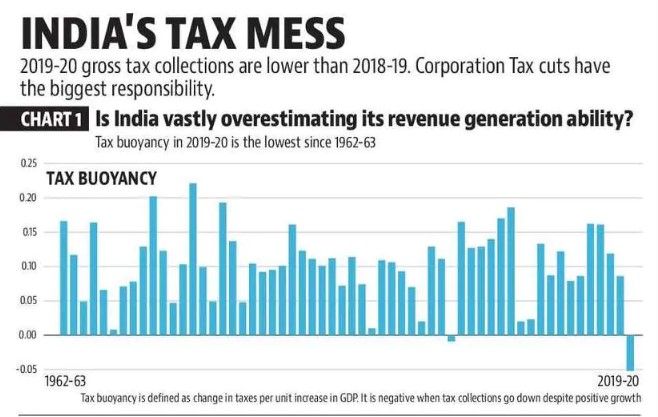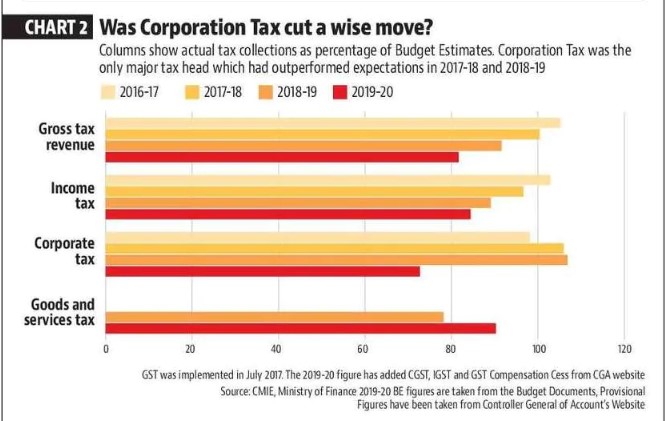Focus: GS-III Indian Economy
What leads up to Corporate Tax cuts?
- The Indian economy had been caught in a slowdown even before the pandemic hit. This made the case for a fiscal push even stronger.
- India’s revenue projection and collection abilities are facing an unprecedented crisis. Gross tax collections in 2019-20 were less than those in 2018-19.
- This is only the second instance since 1961-62 of tax collections having declined on a year- on-year basis.
- This is largely the result of what can be described as a bad gamble on corporation tax cuts to revive economic growth.
Tax Buoyancy Concerns
- These figures raise serious questions on the government’s tax buoyancy assumptions.
- Tax buoyancy is the additional revenue generated per unit increase in GDP.
- If tax collections went down when the economy was growing, they could suffer a huge fall when it is headed for a contraction.
- This also raises serious questions on assertions about decisions such as demonetisation and the Goods and Services Tax (GST) leading to a widening of the tax base.
Reduction in Collection of Tax

Provisional figures for 2019-20 put gross tax collections in 2019-20 at ₹20.09 lakh crore. This is lower than the ₹20.8 lakh crore collected in 2018-19.
The Centre for Monitoring Indian Economy (CMIE) database shows that it is only the second instance (after 2001-02) since 1961-62 that tax collection had fallen on a year-on-year basis.
What explains the fall in tax collections?
- The government announced a reduction in corporation tax rates in September last year.
- It slashed corporate tax rates for domestic manufacturers from 30% to 22%, while for new manufacturing companies; the rate was reduced from 25% to 15% provided they do not claim any exemptions.
- This was expected to lead to a revenue loss of ₹1.45 lakh crore.
- This was justified on the grounds that the move will revive the economy.
Did slashing Corporate Tax work?

- The gamble seems to have backfired badly. The revenue loss is bigger than expected. BE for corporate tax collection was ₹7.66 lakh crore in 2019-20.
- The provisional figures are just ₹5.56 lakh crore, a shortfall of ₹2.09 lakh crore.
- Gross fixed capital formation, which measures new investment activity, contracted 3.9% on a year on year basis in the quarter ending September 2019.
- It contracted at 5.2% and 6.5% in the quarters ending December 2019 and March 2020.
- The only major revenue head which had over performed vis-a-vis BE targets in both 2017-18 and 2018-19 was corporation tax, however, due to September’s tax cuts, this item had the biggest shortfall in 2019-20.
-Source: Hindustan Times



